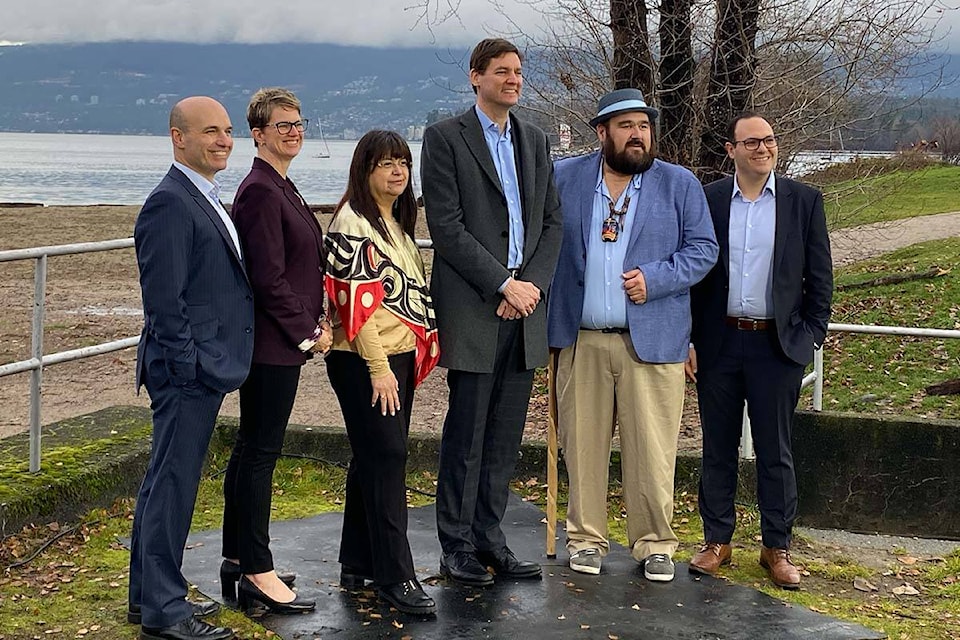What is the best way of reconciling the economic interests of First Nations with their ecological knowledge of those same areas? Or with the interests of government, industry and society at large?
Those questions loomed large when the province Tuesday (Dec. 5) announced a $60-million grant to help support Indigenous-led conservation and sustainable economic development in the Great Bear Sea.
Stretching from top of Vancouver Island to the Canada–Alaska border, including Haida Gwaii, biologists consider the recently dubbed region to be one of Canada’s richest and most diverse ecosystems.
Dallas Smith, president of the Nanwakolas Council representing six members Nations on northern Vancouver Island and the Central Coast, placed Tuesday’s announcement in Vancouver attended by Premier David Eby and Water, Land and Resource Stewardship Minister Nathan Cullen in the tradition of the Great Bear Rainforest Agreement in 2007.
“I remember when we did the Great Bear Rainforest Agreements in 2007, going home expecting fanfare from the communities,” Smith said. “And the Elders pulled me aside and said, ‘Don’t sprain your arm patting yourself on the back until you have done the marine component, because we are Ocean People,’” he said.
Coast Conservation Endowment Fund Foundation, the world’s first Indigenous-led conservation finance organization, will manage the grant on behalf of participating First Nations with an eye toward raising another $200 million toward the development of the Great Bear Sea Project Finance for Permanence (PFP) initiative.
RELATED: Feds promise $500M to ‘fast track’ old-growth, habitat protection work in B.C.
PFPs broadly blend public and private-sector investments for long-term conservation and economic benefits and the Great Bear Sea PFP is among four Indigenous-led PFPs in development across Canada.
The Great Bear Sea PFP supplies long-term funding for the implementation of an environmental protection plan involving First Nations, Victoria, Ottawa, industry and community interest that was first announced in February, as well as a multi-use plan involving Victoria and First Nations.
The Great Bear Sea PFP is expected to create 2,000 full-time jobs in fisheries and other industries, while developing a network of marine protected areas with Indigenous knowledge, Western science and collaboration among interested parties informing plans.
These protected areas will also count toward B.C.’s goal of protecting 30 per cent of its land base and 30 per cent of its marine area by 2030.
While this overarching goal has broad support and recently received $1 billion in funding for senior levels of government, environmentalists have expressed concerns government won’t end up protecting the most threatened and valuable ecosystems. Protection efforts must also consider the economic, political and legal rights of First Nations under the heading of Indigenous-led conservation.
Smith alluded to these complexities in his remarks.
“It’s easy to identify the area (slated for protection), but to lock these things in for the long-term legacy piece that is needed to combat climate change and other issues, we need to really find how that balance works. So we are working we all of all our partners at the federal and provincial government to find out where our economic interests are, so we can lock down the these protected areas for the long-term.”
That can be a challenge, he said, calling it a work-in-progress.
“We have land questions in there, we have (unresolved) treaty processes in play, but these are all part of the discussion now,” he said.
Part of the answers will flow from the public feedback to B.C.’s biodiversity and ecosystem health framework currently circulating in draft form.
According to the provincial government, it “sets out a common vision for the conservation and management of ecosystem health and biodiversity.” Its “overarching priority” is formalize a “new and strategic direction for a more holistic approach” in the stewardship of land and water resources and “making sure they are healthy and resilient for future generations.”
Cullen said the province will continue to collect feedback until about the middle of January.
“(Then) we will be coming back to the people of B.C. with a new way of looking at resource extraction and conservation through that Indigenous-led lens,” Cullen said.
Tuesday’s immediate announcement drew praise from the Wilderness Committee.
“We are very pleased to see this announcement,” Charlotte Dawe, conservation and policy campaigner, said. “Time will tell what type of initiatives this will ultimately fund and which Nations will have access to the funds. But we are hoping this fund can help coastal communities to move away from extraction heavy resource industries to jobs and projects that protect and restore water and marine life.”
Dawe said her own experience of having worked on northern Vancouver Island show a “huge need” for stream-walks to measure salmon returns and stream restoration work to increase salmon habitat and long-term survivability.
“We’re hoping to see some of these funds go towards First Nation led projects like this,” she said.
@wolfgangdepner
wolfgang.depner@blackpress.ca
Like us on Facebook and follow us on Twitter.
